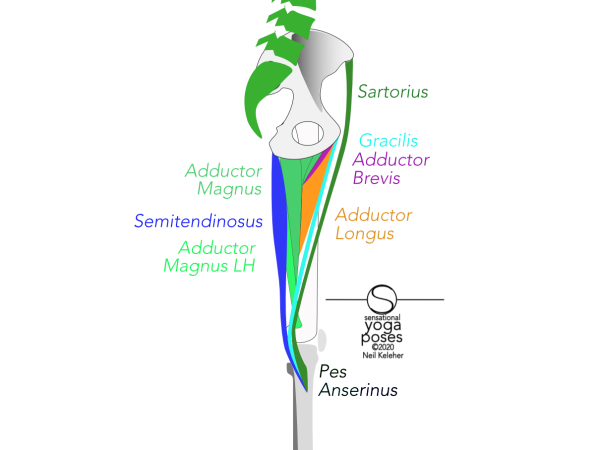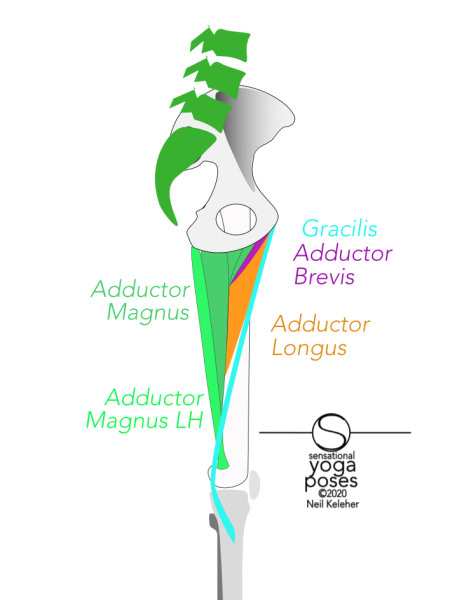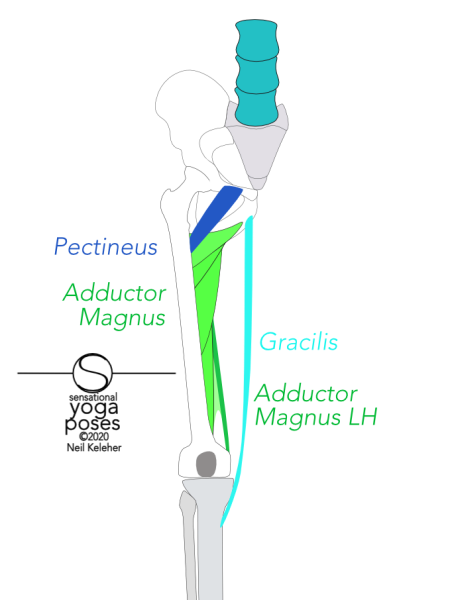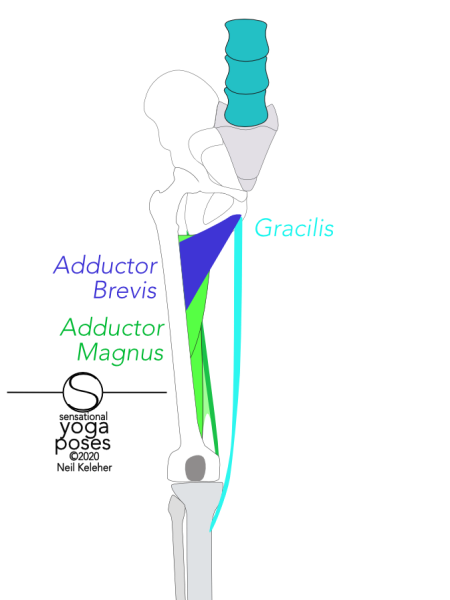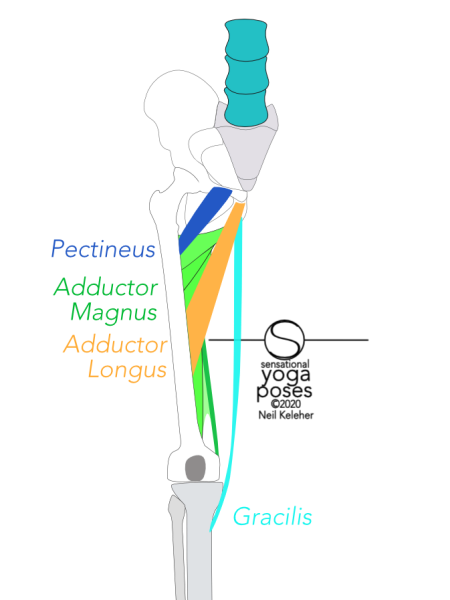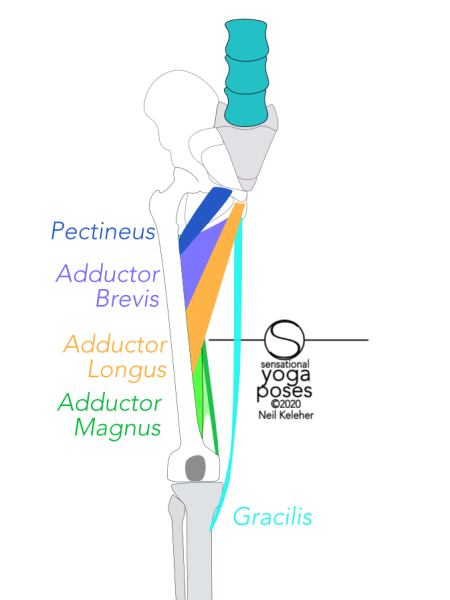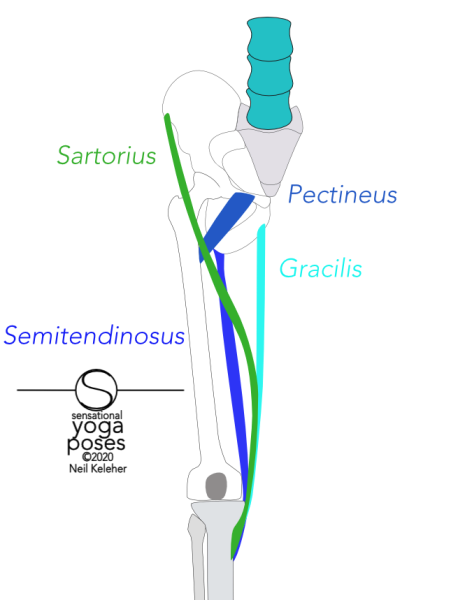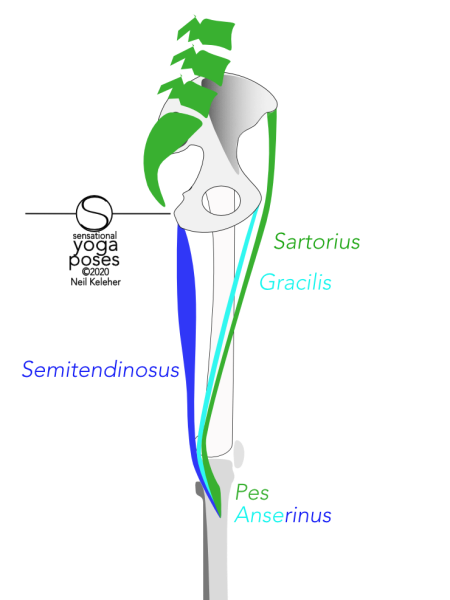Adductors and inner thigh muscles
The muscles that adduct (and resist abduction), and that help control flexion, extension and rotation of the hip joint
The adductors as a group are generally said to consist of five muscles. In this article I'll focus on all of the inner thigh muscles that can be used to adduct the hip joint as well as some of the muscles that resist adduction. These muscles not only work to control adduction. They can also help to control hip flexion and extension as well as hip rotation.
Adductors and inner thigh muscles Index/TOC
The word adduct means to draw inwards towards the center line. Abduct has the opposite meaning, pulling away from the center line. With respect to the hips, the hip adductors draw the leg (or legs) inwards while the hip abductors move the legs outwards.
What muscles cause hip adduction?
Muscles along the inner thigh tend to pull the legs inwards, adducting the hip joint while muscles along the outer hip pull the leg outwards, abducting the hip joint.
In general, the muscles that pull the thigh inwards relative to the hip bone are noteworthy because they attach to prominent corner points of the hip bone. The muscles commonly called the adductors attach to the pubic bone and ischial tuberosity and points in-between. This means that the adductors, as well as being hip joint adductors can also play a role in tilting the hip bone forwards or backwards or resisting the hip bone from tilting forwards or backwards.
They help to control extension and flexion of the hip joint.
With respect to the femur, or thigh bone, the bulk of the adductors attach to the back edge of the femur. Two noticeable exceptions are the gracilis, which attaches to the inner edge of the top of the tibia, and the adductor magnus long head which attaches to the back of the inner edge of the femur.
The adductors that attach to the back edge of the femur can be used to rotate the thigh externally relative to the hip or to resist external rotation. Likewise, assuming the knee is straight, the gracilis. The adductor magnus long head tends to neutralize external rotation.
So as a whole the adductors can also help to control hip rotation.
Understanding these two simple points gives us some alternatives for working on the adductors and even for warming them up.
Before going on, the muscles that are commonly referred to as the adductors are the pectineus, adductor brevis, adductor longus, adductor magnus (which can be divided into two parts) and the gracilis.
If you imagine the front rim of the hip bone as extending from the front point of the hip crest to the pubic bone, the pectineus attaches to this rim just adjacent to the pubic bone (pubic synthesis). The psoas and iliacus pass over it or close to it when they fold around the front rim of the pelvis to attach to the inner edge of the femur at the lesser trochanter.
It attaches to the pectineal line of the femur, a line along the inner surface of the femur that connects the lesser trochanter to the edge running down the back of the femur called the linea aspera.
Attaching below the front of the rim of the pelvis, below the pubic crest and to the side of the pubic bone, and so below the line of attachment of the pectineus, the adductor brevis muscle attaches to the line aspera at the back of the femur, lateral wards or outwards from the attachment of the pectineus. It is the shortest of the hip adductor muscles that contain the work adductor in their name.
The adductor longus attaches below the front rim of the hip but ahead of the adductor brevis. It attaches to the linea aspera below the adductor brevis. Viewed from the front, the adductor longus is positioned in front of the adductor brevis.
The bottom rocker of the hip bone is called the ischiopubo ramus. The opening just above this bone (and below the socket of the hip joint) is called the obturator foramen.
The adductor magnus has a rather long line of attachment to the outer surface of the ischiopuboramus below the bottom of the obturator foramen. (This can be thought of as the adductor magnus long headIt's line of attachment is adjacent or next to the bottom edge of the obturator externus muscles area of attachment. In addition, the front end of the adductor magnus's line of attachment has some overlap with that of the adductor brevis.
The back end of its attachment to the hip bone ends below that of the quadratus femoris and just before the attachment of the hamstring muscles to the ischial tuberosity, the bottom surface of which tends to be called the sitting bones.
The adductor magnus also has a broad attachment to the femur, attaching to most of the length of the linea aspera. Fibers from the front of the hip bone attach higher on the linea aspera while fibers towards the back attach lower.
It's posterior surface relates to the gluteus maximus as well as the hamstring muscles. The hamstrings include: semitendinosus, semimembranosus, biceps femoris.
It's inner border relates to both the gracilis muscle and the sartorius.
The gracilis attaches to the outer and front surface of the ischiopuboramus just below the adductor brevis. It runs down the inside of the thigh to attach to the top of the fibula via the pes anserinus.
Two other muscles that attach to the pes anserinus are the sartorius and the semitendinosus. These two muscles can also play a role in adduction. Since they also attach to prominent corner points of the hip bone they can also help to control hip flexion and extension or if you like forward and backward tilting of the hip bone as well as lateral or left/right rotation.
Sartorius attaches to the ASIC, the front point of the hip crest. It connects to the tibia at the pes anserinus above the gracilis.
Semitendinosus is one of the hamstring muscles. It attaches to the ischial tuberosity and at the pes anserinus below the gracilis.
Because each of these three pes anserinus muscles attach to three different corner points of the hip bone they can possibly come into play to adduct or resist adduction for a range of hip joint positions. They can also help to control rotation and tilting for a range of hip positions.
Another important point to note, since these muscles cross both the knee and hip joints is that the shin can rotate relative to the femur when the knee is bent. So these muscles can not only control the hip bone, they can also help control rotation of the shin bone.
These three muscles can be important in straight leg weight bearing adduction in postures and positions like Dancing warrior (standing yoga poses), Side plank for the inner thigh (leg strengthening exercises), and half side splits as well as full side splits
(adductor stretches) to help prevent gapping of the inner aspect of the knee joint.
In bent knee poses and actions where the feet bear weight such as in chair pose, lunges and the bent knee warrior poses (warrior 1 and 2) the pes anserinus muscles can help to stabilize the hip bone of the bent knee assuming the shin is stabilized against rotation.
They could also be used from a stabilized hip bone to control shin rotation as well as inwards or outwards movements of the knee.
Standing on both legs, it's easy to relax the adductors unless you give them an opposing force to work against. That can be provided by the hip abductors as well as the IT band muscles which, similiarly to the pes anserinus muscles, work on both the hip and knee joints.
In either case, it can help to stabilize either the hip bone or the lower leg bones so that these muscles have a stabilized anchor point (or reference) from which to work.
You could think of the pes anserinus muscles, plus the IT band muscles and the hamstrings as "long hip muscles". These muscles aren't just long, they work on two joints, the knee joint and the hip joint and you can read more about how they work together in long hip muscles.
Since these muscles work on both the knee and the joint, they could also be referred to as the "long thigh muscles".
Note that the pes anserinus muscles all have contact with the adductor magnus muscle. With the knee bent, these muscles may loose effective operating tension.
Adductor magnus (and the other adductors as well as the vastus medialis muscle) could activate to push out against these muscles thus removing some slack and giving them enough tension to operate effectively. In so doing, the adductors that work only on the hip joint could work against the abductors to stabilize the hip joint. This would also stabilize the hip bone giving the longer pes anserinus and IT band muscles an anchor from which to work on the shin bone.
You can read about that too in the long hip muscles article.
Published: 2020 02 17
